Lüttmoorsiel-Nordstrandischmoor island railway
The Lüttmoorsiel-Nordstrandischmoor island railway (German: Halligbahn Lüttmoorsiel–Nordstrandischmoor), also called the Loren Railway (Lorenbahn), is a German, 600 mm (1 ft 11 5⁄8 in) narrow gauge island railway through the North Frisian Wadden Sea from Beltringharder Koog on the mainland to the Hallig of Nordstrandischmoor.
| Lüttmoorsiel–Nordstrandischmoor | ||||||||||||||||||||||||||||||||||||||||||||||||||||||||||||||||
|---|---|---|---|---|---|---|---|---|---|---|---|---|---|---|---|---|---|---|---|---|---|---|---|---|---|---|---|---|---|---|---|---|---|---|---|---|---|---|---|---|---|---|---|---|---|---|---|---|---|---|---|---|---|---|---|---|---|---|---|---|---|---|---|---|
 | ||||||||||||||||||||||||||||||||||||||||||||||||||||||||||||||||
| Technical | ||||||||||||||||||||||||||||||||||||||||||||||||||||||||||||||||
| Line length | 3.5 km (2.2 mi) | |||||||||||||||||||||||||||||||||||||||||||||||||||||||||||||||
| Track gauge | 600 mm (1 ft 11 5⁄8 in) | |||||||||||||||||||||||||||||||||||||||||||||||||||||||||||||||
| ||||||||||||||||||||||||||||||||||||||||||||||||||||||||||||||||

Legal status
The line is a non-public railway infrastructure owned by the state of Schleswig-Holstein that is operated by the State Department for Coastal Defence, National Parks and Marine Conservation (Landesbetrieb für Küstenschutz, Nationalpark und Meeresschutz) or LKN-SH – formerly the Office for Rural Regions (Amt für ländliche Räume).
History

The 600 mm (1 ft 11 5⁄8 in) narrow gauge railway was built in 1933/1934 from Cecilienkoog over a pile-supported embankment to Nordstrandischmoor in order to transport construction material for the sea defences of the hallig. Its length was 7 km (4.3 mi). On 1 March 1956 the line was destroyed by ice floes, but later rebuilt. In 1977 the pile dam was filled with rubble to make the line more stable. When the new outer dyke around the Beltringharder Koog was completed, the section of track between the Cecilien Koog and the new outer dyke was abandoned. The annual figures given for this are 1985 and 1988. The rest of the line is still in operation and now has a route length of 3.6 km (2.2 mi). In 2000, a new, paved Lorendamm embankment built, which can now be worked largely independently of the tide table and is only impassable when there is a storm surge.
Infrastructure
The main storage depot for the railway is behind the new outer dyke. This is crossed by a switchback and has a siding on the outer side. It follows the embankment for about 3 km of its length. In the middle there is another siding. On the island, the route branches to Nordstrandischmoor station and Neuwarft, which is the only one of the four warfs on the island of Nordstrandischmoor with its own railway link.
Rolling stock
Some of the stock belongs to the State Department for Coastal Defence and National Parks. There are two locomotives, goods wagons for construction work and two construction wagons (Bauwagen), which provide shelter for the workers during construction work.
The other vehicles belong to the residents of Nordstrandischmoor. Each household has its own wagon. These are draisines powered by internal combustion engine, some with a trailer. Initially, the trucks had sails and were powered by wind. These vehicles are for the personal use of the islanders and their guests. There is no commercial traffic. Drivers must be at least 15 years old and hold a moped licence.
The locals refer to this railway as the Lorenbahn. A Lore is one of the wagons - powered or not - that works the line. This differs from the usual use of the German railway term Lore or Güterlore which refers to a tipper wagon.
Gallery
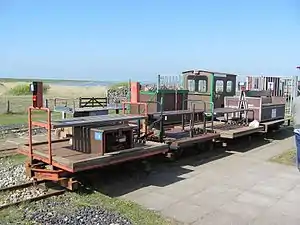 Vehicle park on the mainland
Vehicle park on the mainland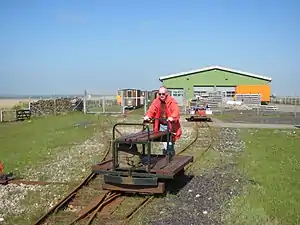 Shunting operations
Shunting operations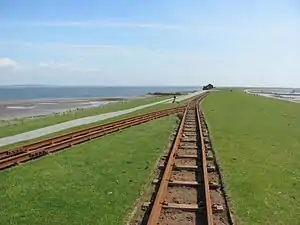 Switchback on the crest of the dyke
Switchback on the crest of the dyke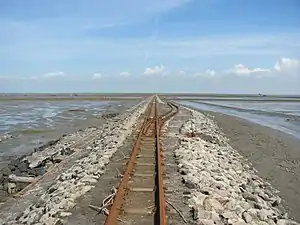 Siding half-way along the embankment
Siding half-way along the embankment The Lorendamm against the evening sky. Right: the Neuwarft.
The Lorendamm against the evening sky. Right: the Neuwarft. A "passenger train"
A "passenger train"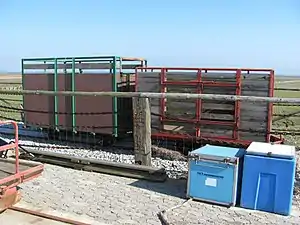 Cattle wagons
Cattle wagons Nordstrandischmoor island station
Nordstrandischmoor island station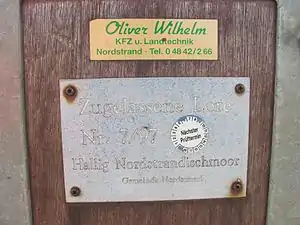 TÜV certificate for a locomotive
TÜV certificate for a locomotive Old track between Cecilien Koog and Lüttmoorsiel (the old embankment is right of the channel).
Old track between Cecilien Koog and Lüttmoorsiel (the old embankment is right of the channel).
Sources
External links
 Media related to Lorenbahn Nordstrandischmoor at Wikimedia Commons
Media related to Lorenbahn Nordstrandischmoor at Wikimedia Commons- Nordstrandischmoor Island Railway (in German)